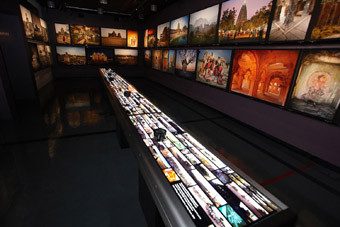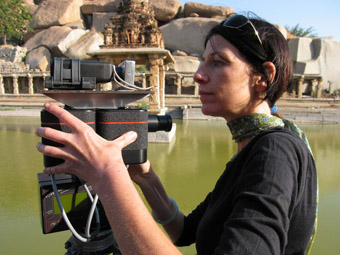 |
The Photography Room in the Ancient Hampi exhibition photo Ben Healley, Museum Victoria |
Place-Hampi is an exhibition that combines the imagery of archaeological sites and discoveries of ancient remains and relics with the sacred and the mythological. Experiments with new media technologies developed by Sarah Kenderdine and Jeffrey Shaw at the iCinema Centre for Interactive Research at the University of New South Wales have resulted in the convergence of archaeology and dreaming. Place-Hampi was commissioned for France-India year (Lille3000) and installed at Lille’s opera house in 2006.
Place-Hampi is divided into four interrelated exhibits presented across adjacent rooms. At the entrance, a topographical aerial map spread across the floor reveals a scaled down version of ancient Hampi. The map details Hampi’s terrain, the proximity of its monuments and denotes architectural features and historical locations. It also invites viewers to project themselves into the space by walking across the landscape. This hints at the interactivity to follow. Place-Hampi visually redefines Michel de Certeau’s differentiation of place and space. For de Certeau, while place is a geographically given and can be mapped, space is constructed by presence and engagement. Place-Hampi begins by defining geographic place and then invites the participant to construct their own sense of this space through movement, interaction and immersion.
The first room houses an exhibition of photographs shot by researchers over a 25-year period. This collection features Hampi’s vivid ochre and pink temples, monumental stone structures and elaborate architectural ruins. Some landscapes are illuminated by direct daylight while others are intensified by hazy sunsets. Layers of panoramic photographs fill the walls orienting visitors to the site, while smaller images spread across a tabletop light box can be inspected using a magnifier. Here the viewer shifts from tourist to investigator, scanning the photographs and focusing on details.
 |
Preparing the Seitz VR Roundshot stereographic panoramic camera for photography at the Krishna Tank photo S. Kenderdine |
Virtual tourists share the space with visitors to Hampi, both material and mythological. On the console, an LCD screen displays an alternative map of Hampi emphasising its symbolic links to Kishkinda, the mythological kingdom of monkeys. The surrounding screen reveals composited images of the Hindu deities Shiva, Ganesha, Sita and Durga, adding a hallucinatory vision to the experience. Artists at the Paprikaas Animation Studio in Bangalore created impressions of these Hindu gods, capturing and modelling their movements on the motion of classical Indian dancers. Sarah Kenderdine describes encounters with the mythological as “somatic engagement”, an embodied affect inspired by the Indian aesthetic tradition of chromolithography. The inscription of mythology over archaeology produces magical realism, connecting present with past to emphasise temporal continuity.
The final room repositions the virtual tourist as a researcher, presenting an impressive collection of the fieldwork that underpins Place-Hampi. Images of archaeological artefacts, newspaper articles, historical photographs and journal entries are imprinted onto plastic pages, which can be projected onto a large screen. The four rooms of the exhibition combine to present an experiential, exploratory (rather than didactic) connection with this ancient landscape. This virtual journey invites an embodied engagement, animating historical artefacts and Hindu gods with the use of new technologies. With their commitment to Place-Hampi, Melbourne’s Immigration Museum invests in new forms of exhibition to offer a unique experience and new imaginings of an ancient site, challenging its visitors to create space from place.
Place-Hampi: Inhabiting the Cultural Imaginary, Sarah Kenderdine and Jeffrey Shaw with John Gollings, Paul Doornbusch, Dr L Subramaniam and Paprikaas Animation; Immigration Museum, Melbourne; Nov 13, 2008-Jan 26, 2009;www.icinema.unsw.edu.au/projects/prj_hampi.html; www.place-hampi.museum
RealTime issue #89 Feb-March 2009 pg. 23
© Wendy Haslem; for permission to reproduce apply to [email protected]








 back
back